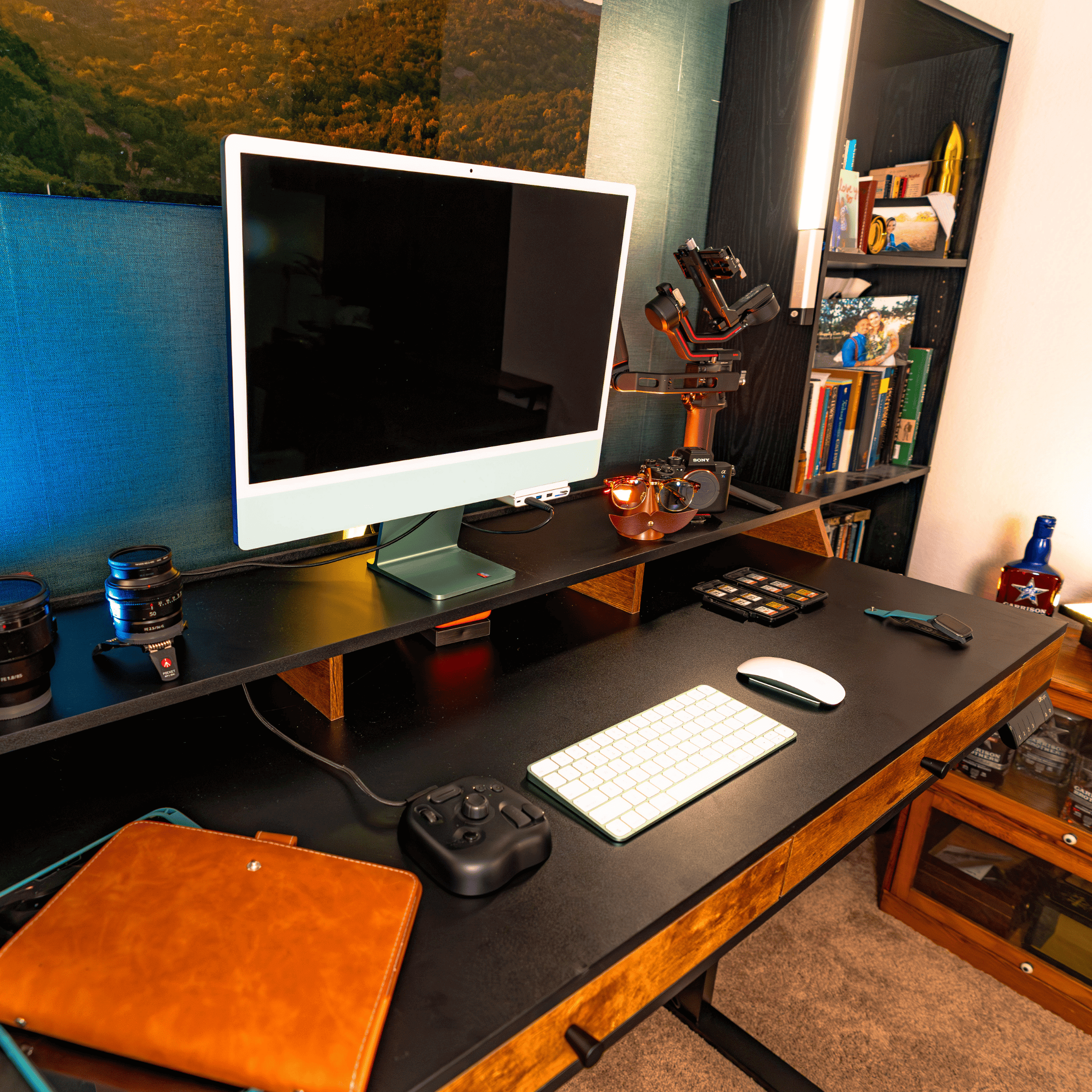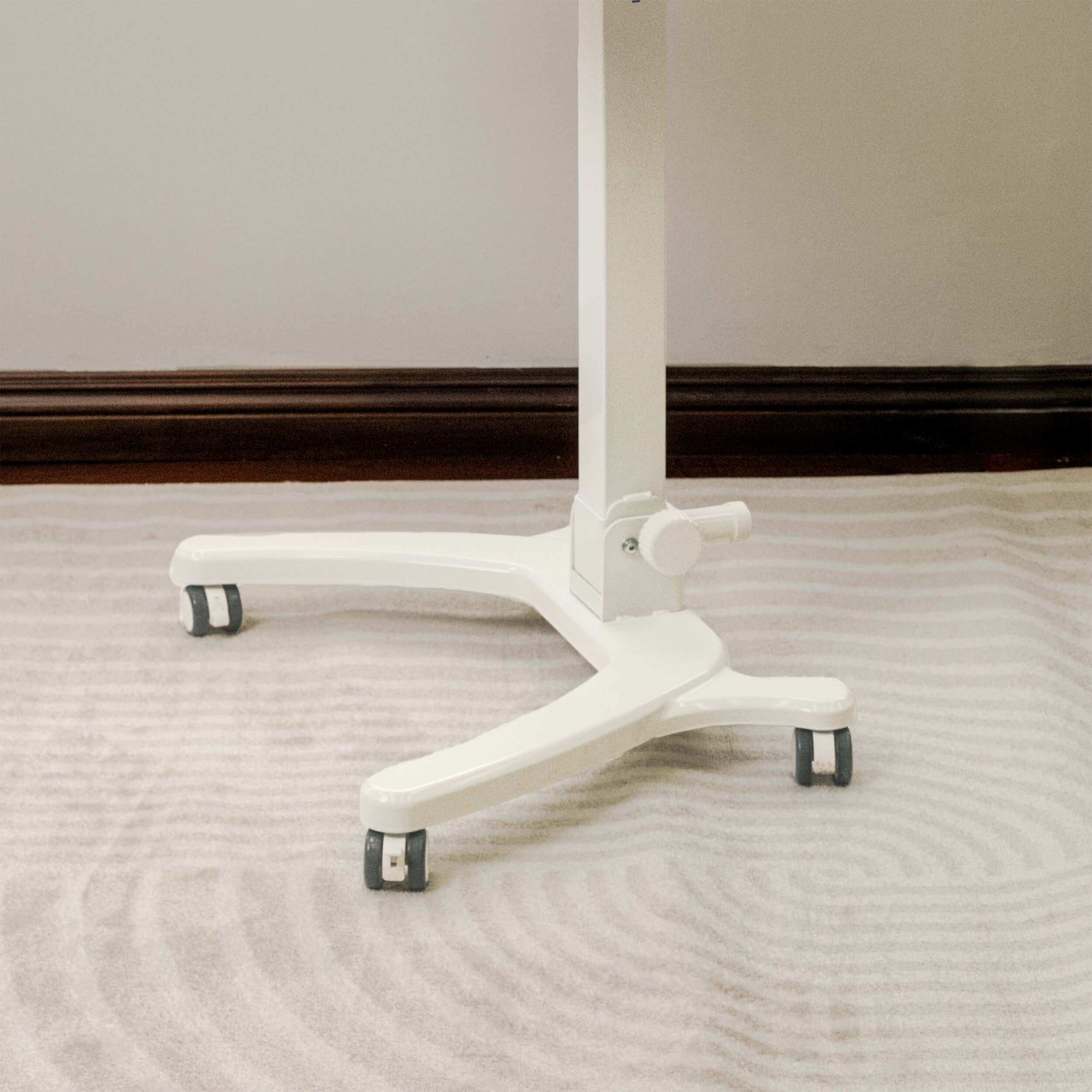The finish and material play a major role in how your four-leg standing desk is going to feel beneath your hands. At the same time, it also affects its appearance and durability. For this reason, we’ve prepared a short list of popular desk materials and surface treatments while listing their pros and cons.
1. Solid wood
Whether it be oak, walnut, cedar, pine, or another natural wood, these are generally known for their durability and aesthetic appeal. As its name suggests, hardwood tends to be more resilient than softwood.

(cedar wood)

(oak wood)

(walnut wood)

(pine or another natural wood)
Pros:
-
Durability
-
Unique grain
-
Natural aesthetics
Cons:
-
Sensitive to humidity and temperature
-
On the heavier side
-
Not as affordable

Pro tip: LiftSync Quad Pro is a four-leg standing desk made of solid wood. It has an advanced stability system and comes with a zero-wobble guarantee. An aesthetically-pleasing and environmentally conscious choice. And, of course, you can adjust it at will. Dimensions: 63 x 31.5.
2. Toughened glass
Thanks to the way it’s made, this kind of glass is stronger than regular glass, so it can take more beating in comparison (to be super technical, it’s about 4 times more resistant). In addition to its increased durability, it also sports a modern look. You can also further enhance its looks by painting the finish.
Pros:
-
Modern look
-
Scratch-resistant
Cons:
-
Prone to lingering fingerprints
-
More fragile compared to alternatives
-
The surface tends to be colder

Make sure to check out LiftSync Clear Plus if the material of glass better fits you.
3. Bamboo
By undergoing a refined production process, bamboo can be transformed into durable panels. Its key advantage is being lightweight yet resilient.

Pros:
-
Eco-friendly
-
Aesthetic appeal
-
Lightweight
Cons:
-
Maintenance-heavy
4. Metal
Typically, a metal four-leg standing desk is made out of either steel or aluminum. It’s a bit cold to the touch, but its durability and modern looks are unparalleled. If you opt for aluminum, you also get to enjoy an increased level of corrosion resistance.

Pros:
-
Durable and resistant to wear and tear
-
Modern and sleek looking
Cons:
-
Slightly cold to the touch
5. Laminate
This type of wood is made from synthetic materials. It’s intended to be a visual replica of the real thing but eliminate its high cost. Typically, this is achieved by bonding a wood-looking surface to a core material (either particleboard or medium-density fiberboard). Due to this, pairing it with any printed pattern of your choosing is fairly straightforward.
Pros:
-
Affordability
-
Easy to maintain
Cons:
-
Edges are prone to chipping over time
-
Not as warm as real wood
6. High-pressure laminate (HPL)
Another synthetic build, but this time around, the manufacturing process is different. HPL is made under high pressure - by compressing thermosetting resins with layers of cellulosic fibers. It’s another budget-friendly solution that doesn’t sacrifice durability. On top of that, it’s resistant to scratches, heat, and stains.
Pros:
-
Affordability
-
Durability
-
Customization
Cons:
-
Not as warm as natural materials
-
Edges are prone to chipping over time

Pro tip: If you prefer cheaper options for LiftSync Quad Pro or any other models from us, go for the Laminate as it maintains most of your experience.
7. Acrylic
Visually, it mimics the appearance of glass, but technically, it’s made from transparent thermoplastic. Compared to glass, it’s lighter (about 2 times more lightweight) and more resistant to impact.

Pros:
-
Lightweight
-
Resistant to impact
-
Finishes can be in different colors
Cons:
-
Prone to scratches
-
Not as resistant to heat
8. Plywood
Plywood is produced by bonding together multiple layers of wood veneers in order to make them stronger and more durable. It’s not only durable but also resistant to warping. Moreover, it’s available in several grades so as to accommodate different uses.

Pros:
-
Beats particleboard in terms of strength
-
Versatility
-
Light in weight
Cons:
-
Not as affordable as particleboard or MDF
-
Edges require special finishes
9. Fiberboard and particleboard
This is a composite material. It’s produced by compressing wood particles with adhesives. The idea is to produce a material that mimics the looks of real wood, all while making it more affordable and customizable by applying different finishes (examples: veneer and laminate).

Pros:
-
Affordability
-
Lightweight
-
Customizable
Cons:
-
Questionable durability
-
May emit volatile organic compounds
10. Wood veneer
This is a thin layer of wood that functions as an outer layer of various core materials (examples include plywood, MDF, and particleboard). It’s both durable and affordable.

Pros:
-
Lightweight
-
Affordability
-
Natural looks
Cons:
-
Requires proper treatment, or damage can follow
11. Melamine
A resin-coated surface is applied to a core (such as MDF or particleboard). This gives it a protective layer that has a positive effect on its durability.

Pros:
-
Resistant to scratches and moisture
-
Available in different stylistic finishes
-
Affordable
-
Easy maintenance
Cons:
-
Edges are prone to chipping
-
Lacks the look of a natural wood
Things to keep in mind when choosing the right materials for your desk
Since a four leg standing desk is going to serve you for quite a while, it makes sense to pick something that does a good job of what it’s supposed to do and appeal to your sense of aesthetics all at the same time.
With this in mind, we’ve prepared a couple of short pointers on what you should be looking for when selecting desk materials and surface treatments:
-
Budget. Ideally, you should set it before you begin your search and not exceed it. Just know that, with desks, it’s like anything else - you get what you pay for.
-
Maintenance. Ask yourself how much maintenance you’re comfortable with performing. If keeping things simple is a priority, go for surfaces that don’t require such extensive upkeep (laminate or tempered glass are both fantastic options).
-
Fire resistance. If you’re going to be working in an industrial environment, it’s a good idea to pay attention to fire safety. Certain treated woods and metal desks are your best bet in this regard.
-
Durability. If you need something that can take a beating, high-pressure laminate or solid wood are both excellent choices.
-
Aesthetics. A desk that looks neat can play an important role in keeping you motivated for work.
-
Eco-friendliness. For those who realize that we only have one Mother Nature and that we all must do our part to preserve it, the choice of material from which it’s made from matters a lot. If this describes you, go for environmentally conscious choices like recycled wood or bamboo.
-
Functionality. Once again, this depends on your unique requirements and needs. Do you need extra storage compartments or perhaps an adjustable frame?

Pro tip: If storage is a concern, give LiftSync Shelfy a go! It has plenty of extra space to fit your extra screens and other office essentials while still retaining its compact dimensions. In addition to that, it boasts a dimmable LED system and clean white frame. Plus, It’s made from white oak.
Dimensions: 48 x 24.
Conclusion
Choosing the right finish and materials for your traditional or four-leg standing desk matters from multiple perspectives because your choice directly correlates with how durable, long-lasting, and aesthetically pleasing it’s going to be. In other words, picking something that’s both pretty as well as functional is the way to go, as long as it fits your budget.
And, if you’re ready to finally kiss goodbye to the sedentary lifestyle and do something for your health, make sure to check out our finest selection of standing desks.







Share: